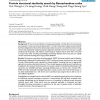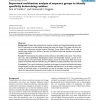167 search results - page 15 / 34 » The accuracy of several multiple sequence alignment programs... |
BMCBI
2007
13 years 7 months ago
2007
Background: Protein structural data has increased exponentially, such that fast and accurate tools are necessary to access structure similarity search. To improve the search speed...
BMCBI
2007
13 years 7 months ago
2007
Background: Proteins that evolve from a common ancestor can change functionality over time, and it is important to be able identify residues that cause this change. In this paper ...
WABI
2009
Springer
14 years 2 months ago
2009
Springer
Background: Frameshift mutations in protein-coding DNA sequences produce a drastic change in the resulting protein sequence, which prevents classic protein alignment methods from ...
NAR
2010
13 years 2 months ago
2010
ALTER is an open web-based tool to transform between different multiple sequence alignment formats. The originality of ALTER lies in the fact that it focuses on the specifications...
RECOMB
2003
Springer
14 years 7 months ago
2003
Springer
We describe a novel method for detecting the domain structure of a protein from sequence information alone. The method is based on analyzing multiple sequence alignments that are ...


